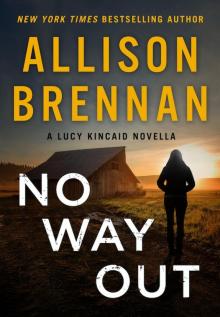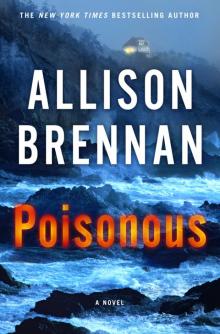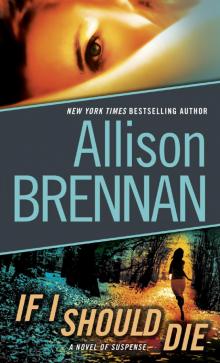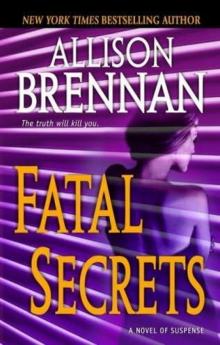- Home
- Allison Brennan
The Third to Die Page 4
The Third to Die Read online
Page 4
“Any suspects?”
“Not yet—we haven’t had an eyewitness or any forensic information that matches anything in our database.”
“Smart killers are rare, but they’re out there.”
He wasn’t confident that her tone referred to killers—or cops. Then she smiled at him.
“If you need anything else from me, call. I’m sure Andy gave you my contact info.”
Matt nodded, trying to think of more questions because Kara Quinn was different—and he couldn’t put his finger on why. But he simply watched as she jogged off at a quick pace.
Then he pulled out his cell phone as he walked back down to the lake. “Ryder, it’s Matt Costa.”
“Yes, sir.”
“Don’t call me sir.”
“Sorry, sir.”
Matt rolled his eyes, feeling like he was in a damn movie. He liked Ryder a lot—they’d been the only two people officially working on the MRT unit until now—but the kid couldn’t seem to drop the formalities, no matter what Matt said or did. Matt supposed he couldn’t undo three years in the military in only a few months.
“I need everything you can find on the witness who found Manners. Detective Kara Quinn, Los Angeles PD, here on vacation. Confirm her identity, background, training, how long she’s been a cop, what she did before, the name of her superior officer. If he’ll talk, talk to him. Find out where she’s staying locally, if she has family here, the whole nine yards.”
“I’m on it, sir. Special Agent Harris will be arriving at sixteen hundred hours, and Jim Esteban is flying in tonight from Dallas.”
That was fast—Matt didn’t think he’d have Michael or Jim until tomorrow.
“And the mobile crime lab?”
“AD Greer is working on it, but it likely won’t be ready for at least a week.”
If they didn’t solve this case in the next week, they wouldn’t need the mobile lab.
“I’ll play nice with the locals and see if we can have access to their lab if we need it, to save time instead of shipping everything to Quantico. I’m still at the lake but heading to the morgue in Spokane in a few.”
Matt ended the call, wondering how the hell they were going to logistically manage an MRT crime lab. It wasn’t an issue for this case because they didn’t have the lab yet, but even if they had people rotating while driving 24 hours a day, it would take a minimum of three full days and nights to drive one cross-country. Once in full operation the MRT wouldn’t be able to wait days for the decked-out RV. Tony had said if the MRT program was successful, his goal was to have two fully equipped RVs, one on each coast. But what about snow? Storms? This was the one part of the program Matt didn’t think Tony had fully thought through.
In concept the MRT was terrific. One of the reasons it would be an asset was that most rural communities didn’t have extensive forensic capabilities, and having an FBI mobile lab available and prepared to process evidence would be a huge benefit. But practically? Matt didn’t see it working.
He supposed they could load the RV up on a military transport plane. For now, he didn’t have to worry about it.
Matt glanced at his watch. It was a straight shot west on I-90 from Liberty Lake to Spokane, about twenty minutes, so he had a bit more time to look around. He walked fifteen feet along the edge of the lake. It was clear to him that Quinn was right—the killer spent some time here. The rocks were pressed into the damp soil, there were footprints, though nothing clear enough to get an impression, and several plants that had been flattened.
Why?
To wash his hands?
Change his clothes?
Dispose of the weapon?
He stared out at the lake, at the thin layer of fog over the surface that didn’t reach the shore. He squatted and dipped his hand in the water.
Damn, that was fucking cold.
He jotted down a few notes—Manners was killed at the edge of the lake, but the water didn’t touch her body. Quinn had spotted the neon stethoscope from fifty feet—not impossible, because it was a bright pink beacon in a sea of brown and green. And she was a cop, so it was reasonable that she might investigate out of sheer curiosity.
The ATV had been parked five feet to the left of the body. That was evident because of deeper ruts from when the killer started up the vehicle and drove off. Ten feet from the ATV, right on the edge of the lake, is where he may have cleaned up.
Matt followed the ATV tracks fifty feet north, along the water’s edge. Then they turned and went back up to the trail. Why had the killer not returned the way he came? Had he disposed of something in the lake? Was someone else in the vicinity he didn’t want to come in contact with?
He started back up the slope toward his car and called Ryder for the second time that morning. It took several rings before he answered. “Sorry, sir, I was speaking with—”
“No need to explain. Call Jessica Torino—she’s the SSA in charge of the Spokane Resident Agency. First, explain our unit and what we’re doing in her jurisdiction. Apologize that I didn’t call her myself, that I’m with the locals or whatever sounds good. If she pushes back, call her boss in Seattle.” He hadn’t had time between last night and this morning to smooth over jurisdictional issues, even though it was on his list of things to do. Tony had made it very clear that he needed to befriend the locals—including regional FBI offices—to help with the MRT image. He hoped Torino wouldn’t cause a problem. This killer wasn’t going to wait around for pleasantries, and neither was Matt. “Find out if they have an underwater search and rescue or recovery unit. If not, find out who they use and whether they’re good. I need divers at the lake. I’ll send you the area I want searched.”
“Looking for a body or evidence?”
“Evidence,” Matt said.
“Agent Harris is certified for underwater search, rescue and recovery.”
Matt knew that; he’d forgotten the fact. Michael was a former Navy SEAL and had many skills that were useful to the FBI.
“We’ll still need equipment and support.”
“On it, sir.”
“Don’t—” But Ryder had already hung up.
6
Spokane, Washington
9:05 a.m.
Detective Andy Knolls was taller than Matt by a good three inches—and Matt wasn’t a short guy. Knolls was also reed thin with a long face and pale blue eyes. He walked with a slight hunch as if he hadn’t been comfortable with his height growing up.
“Good to put a face with a voice,” Knolls said, and extended his hand when Matt met him outside the morgue.
“I just came from the crime scene,” Matt said. “The witness showed up. Kara Quinn.”
Knolls smiled widely. “Ain’t she something? Eyes like a hawk.”
“I gather you know her?”
“Not really. I mean, Liberty Lake is a small town. I know Emily Dorsey—her grandmother. Met Kara a few times back when she was a teenager and living with Emily. I was a rookie. She’s a cop now, down in Los Angeles.”
“You didn’t tell me that our witness was a cop.”
“I guess I didn’t. Sorry.” He didn’t sound sorry or worried.
“I found blood on a rock near the crime scene—where the killer stopped and may have washed up.”
“You know how cold that water is, Agent Costa?”
“Call me Matt.”
“It’s barely above freezing, Matt. Most winters it freezes over, though we don’t let people skate on it. It’s deep, the ice is thin. The guy would have to be crazy to jump in that.”
Jump in the lake? “I didn’t say he went for a swim. I said he cleaned up.”
“Kara seemed to think he jumped. You should talk to the head of Spokane’s forensic investigations, Miles Jordan. Anything like this, Spokane comes in to assist. Jordan thoroughly processed the crime scene. Kara talke
d to him, pointed out a few things. Don’t know that he appreciated her help, but I did. Couldn’t have asked for a better witness.”
Matt was still skeptical. He didn’t know Quinn or her background, and that she was involved with the investigation—before he even got here—made him both curious and suspicious.
A woman in scrubs pushed open a swinging door. “You can come in and suit up, Officers.”
They used the small staff room in the morgue to pull on disposable gowns, booties, gloves, and hats. “We don’t usually have law enforcement witness our autopsies,” she said. “We record every homicide or suspicious death.”
“Good,” Matt said, “but I’d like to get a sense of what happened to the victim.”
The woman eyed him as if he’d never investigated a homicide. “Dr. Reynolds will provide a full report, and we video every exam,” she repeated. “Your presence isn’t necessary.”
“It helps me, from a profiling stance, better understand the crime when I observe. I’ll stay out of your way.”
She gave him a skeptical look, then led them inside the autopsy room.
Dr. Reynolds didn’t seem to have the same animosity at being observed as his pathologist. He laid out his lab rules, and then said, “The last cop I had in here puked. I do not tolerate puking in my lab. You will leave before you contaminate my space, understood?”
“No puking. Got it,” Matt said.
The victim, Victoria Manners, had been prepped. Now that her body was naked and clean, it was clear that the killer had cut her body sternum to navel, then sliced it three times across the midsection, giving it the appearance of having been gutted. It seemed ritualistic. Kara Quinn had been right.
Three times across the midsection. Three is important to him. March 3. Three victims, three days apart. Three years to cool off and start again. Three.
The wounds were so deep that no one could have survived even the first cut.
While observing autopsies wasn’t routine for FBI agents, Matt had done his share over the years, sitting in on a couple dozen, starting with two during his training at Quantico. He wasn’t concerned about his reaction, though Knolls looked a little green.
“No puking, Knolls,” Matt whispered.
“You don’t mind if I sit this out?”
“Not at all. Can you inspect her personal effects, see if there’s anything the CSI missed? And arrange a meet with Jordan. I have some questions.”
Knolls nodded, then left the room. Matt caught the disapproving eye of the pathologist and winked. She frowned and turned back to the doctor.
The pathologist started the recording. “Nancy Waring, senior pathologist with the Spokane County Medical Examiners Office, assisting Chief Medical Examiner Douglas Reynolds during the autopsy of Victoria Manners, twenty-eight.” For the record, she detailed how Manners had been identified. She glanced at Matt. “Also present is FBI Agent Mathias Costa.”
Matt said, “Special Agent in Charge. Just to clarify. You can call me Matt.”
He’d told Tony he didn’t want or need the promotion—Quinn was right about one thing, once agents moved up the ranks, they often turned into dicks. But having the promotion was vital to establish a chain of command, and it gave him authority in most investigations—including seniority over local FBI staff.
Since he didn’t particularly like Nancy Waring or her bureaucratic attitude, establishing a bit of authority right from the gate seemed both appropriate and fun.
Dr. Reynolds worked swiftly and methodically on the autopsy of Manners, both the external and internal examinations, while also asking Matt questions. “You’re not from the Spokane office. Seattle?” The Spokane Resident Agency was under the larger Seattle district office umbrella.
“No, Doc. I’m with the FBI Mobile Response Team.”
“Never heard of it. Is it like the Evidence Response Team? They have one out of Seattle. I’ve worked with them a few times over the years.”
“Similar, yes. The ERT has advanced training in evidence collection and processing. But they’re limited in scope and only work in their local jurisdictions. The MRT was established to assist in special circumstances—like this case—specifically in small, rural communities underserved by local and state law enforcement. Our team—which, to be honest, is still being built—has a broader jurisdiction, and consists of experts in every facet of criminal investigations. We’re not limited to forensics, but handle the full investigation.” At least that was the goal once the team was fully staffed.
“Spokane is hardly rural.”
“The body was found in Liberty Lake,” Matt said. “And we believe the Manners murder connects with several other homicides over the past six years in two other states.”
“Serial killer,” Reynolds said bluntly.
Matt didn’t comment. Instead, he let the Chief Medical Examiner do his job.
Spokane might be a large city by Washington standards, but its Resident Agency had a large geographic jurisdiction and bare-bones staff. Matt hadn’t even had time to meet with the Spokane Supervisory Special Agent, Jessica Torino. In a perfect world, he would have gone through her office first to minimize stepping on too many toes, but this case was time sensitive. He hoped Ryder had reached her and she was cooperative.
The ME repeated his findings for the tape. Manners died of massive blood loss as a result of four deep knife wounds. “It’s my opinion, Agent Costa, that the first cut was fatal. The knife went so deep it punctured the posterior of her stomach. Then he sliced down, through her other organs. It takes some strength, and there doesn’t appear to be any hesitation marks—though with the extreme damage to the body, they may not be obvious.”
“And the other three cuts?”
“Not as deep, but they would have certainly been fatal as well. Every organ was compromised in some way.”
“The killer right-or left-handed?”
“The victim was on her back during the attack. The cuts on her right side—or the killer’s left side, since he had to be facing her—are deeper, then become more shallow as the knife reaches the opposite side and exits the body. As if he stabbed the knife into her, then sliced through at an upward angle. I would be confident in stating that the killer is right-handed.”
Along with 90 percent of the population. But Quinn was right again.
“Was she drugged?”
“There are no defensive wounds, and I’ve sent blood and tissue samples to our lab. It’ll take a couple of days to process.”
This was where the MRT crime lab would come in handy. They could process evidence far quicker because they would only be working on one case at a time. Jim Esteban would be here tonight and Matt was going to have him sweet-talk the crime lab into access and quicker results.
“What about a blow to the head? Any other external injuries?”
“No excessive bruising, no blunt force trauma. There were bindings on her wrists and ankles—but she didn’t struggle against them, so that suggests she was tied up while unconscious.”
Matt would work with CSI on expediting the reports, but he was almost positive she had been drugged. But how? She hadn’t fought back. He also wanted any trace evidence from the restraints.
“Sexual assault?” Matt asked.
“No,” the ME said. “A small blessing.”
Hardly a blessing when Victoria Manners was still dead.
“If I send you the autopsy files of six other victims we believe are the work of the same killer, would you be able to review them and give your expert opinion as to whether they are the same, different, or indeterminate?”
“I would.”
“You’ll have them before the end of today.” He quickly sent Ryder a message to expedite delivering the reports to Reynolds.
If this was the same killer—and Matt was 99 percent positive it was—then he would kill someone else
on Saturday. Less than thirty-nine hours from now. Man, woman, black, white, didn’t matter—it was random.
Appeared random, he told himself. Because to the killer, Matt was certain there was a reason he chose each victim. The dates were important to him—perhaps the only thing that was important—but it stood to reason he chose his victims as carefully as the dates of their murders. Just because they couldn’t see the connection didn’t mean there wasn’t one.
“Is it possible to give us specs on the weapon?” Matt asked.
“I need to do some research on that. The blade was at least four inches and double-edged. That’s all I can determine without taking additional measurements and running them through the computer.”
“Fair enough.” All the other victims were killed with a double-sided blade.
“I did notice something else,” Reynolds said.
Matt stepped forward. Victoria’s body was still open; Reynolds would sew her up and store her until her family claimed the remains. Anger hit Matt, as it often did when he saw an innocent victim. But he swallowed it. He was the calm one, the reasoned, methodical cop. It’s why he did his job so damn well.
Didn’t mean he wasn’t pissed off.
Reynolds said, “One of her shoes was missing when she was brought in, and according to the CSI report, it wasn’t at the crime scene. I don’t know if the killer takes souvenirs, or he tossed it in the lake, or what.”
“No souvenirs, to our knowledge.” Which was interesting in and of itself. Most serial killers took something from their victims. Most—not all. Shrinks had different theories about souvenir collection, but Matt thought that when this particular killer was done, he was done. Victim dead, didn’t give them a second thought. Didn’t need to relive the moment months later. Maybe that’s one reason he was so methodical in his timeline—he didn’t need an object to remember his crimes.
“She was wearing a special brand of support panty hose that many nurses wear while on duty—the hose on her right foot was cut.”

 The Third to Die
The Third to Die Nothing to Hide
Nothing to Hide No Way Out
No Way Out Cold as Ice
Cold as Ice Cut and Run
Cut and Run No Way Out (Lucy Kincaid Novels)
No Way Out (Lucy Kincaid Novels) Storm Warning
Storm Warning Betrayed: Powerful Stories of Kick-Ass Crime Survivors
Betrayed: Powerful Stories of Kick-Ass Crime Survivors Killing Fear pb-1
Killing Fear pb-1 Make Them Pay
Make Them Pay The Lost Girls
The Lost Girls Stalked
Stalked Killing Justice
Killing Justice A Deeper Fear
A Deeper Fear Poisonous
Poisonous Fear No Evil
Fear No Evil Playing Dead
Playing Dead Cold Snap
Cold Snap Vacation Interrupted
Vacation Interrupted Frosted (Moreno & Hart Mysteries)
Frosted (Moreno & Hart Mysteries) 2 - The Hunt
2 - The Hunt Stolen
Stolen No Good Deed
No Good Deed Cutting Edge
Cutting Edge Deliver Us from Evil
Deliver Us from Evil If I Should Die
If I Should Die Speak No Evil
Speak No Evil Silenced lk-4
Silenced lk-4 Original Sin sds-1
Original Sin sds-1 Kiss Me, Kill Me lk-2
Kiss Me, Kill Me lk-2 What You Can’t See
What You Can’t See See No Evil
See No Evil The Prey
The Prey Maximum Exposure
Maximum Exposure Fatal Secrets f-2
Fatal Secrets f-2 Stalked lk-5
Stalked lk-5 Cutting Edge f-3
Cutting Edge f-3 Hit and Run (Moreno & Hart Mysteries)
Hit and Run (Moreno & Hart Mysteries) Sudden Death f-1
Sudden Death f-1 If I Should Die lk-3
If I Should Die lk-3 Notorious
Notorious Abandoned
Abandoned Fatal Secrets
Fatal Secrets The Hunt
The Hunt Carnal Sin sds-2
Carnal Sin sds-2 Love Is Murder
Love Is Murder Lost and Found
Lost and Found TWO TO DIE FOR
TWO TO DIE FOR Breaking Point
Breaking Point Best Laid Plans
Best Laid Plans Carnal Sin
Carnal Sin Silenced
Silenced Dead Heat
Dead Heat Crash and Burn
Crash and Burn Sudden Death
Sudden Death Lucy - 05 - Stalked
Lucy - 05 - Stalked Mortal Sin
Mortal Sin Playing Dead pb-3
Playing Dead pb-3 Kiss Me, Kill Me
Kiss Me, Kill Me Original Sin: The Seven Deadly Sins
Original Sin: The Seven Deadly Sins See No Evil e-2
See No Evil e-2 Cutting Edge: A Novel of Suspense
Cutting Edge: A Novel of Suspense Original Sin
Original Sin Too Far Gone
Too Far Gone Tempting Evil
Tempting Evil Shattered
Shattered Killing Fear
Killing Fear Murder in the River City
Murder in the River City Love Is Murder (lucy kincaid)
Love Is Murder (lucy kincaid) Stolen (Lucy Kincaid Novels)
Stolen (Lucy Kincaid Novels)